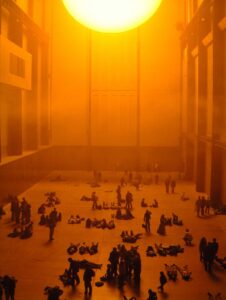Sites
Independent research based on lecture:
This week’s in-depth discussion of site-specific art has given me an overview of how it is created, its relationship to space and audience, and its importance in contemporary art. Site-specific art emerged in the late 1960s as a reaction to the increasing commodification of art and the prevailing ideals of artistic autonomy and universality. At the same time, place art has been shown to have a role in exposing repressed histories, providing support for marginalized groups, and how facilitating important discoveries about “small places” that have been overlooked by mainstream culture. (Kwon and Miwon, 2002). The various sources also explore the integration of site-specific art with contemporary performing art, pointing out the importance of audience interaction and the timeliness of art based in a particular place. In my explorations, I discovered that Olafur Eliasson’s 2003 installation at Tate Modern, The Weather Project, embodied this concept, which transformed the vast turbine hall into an immersive environment with atmospheric effects.
Photo: Tate Photography © Olafur Eliasson(2003)
About personal curatorial project and collective project:
In addition, in the afternoon workshop, through the communication with CAP students, I have further thought about my curatorial project, and I want to explore how different types of space affect the audience’s experience of artwork. Some scholars have shown that vested interests may be the best driving force for various basic preventive behaviors in the context of environmental risks (De Dominicis et al., 2021). In other words, if the audience’s vested interests are taken into account in curating, curators need to ensure that the content of the exhibition is meaningful to the audience while providing a rich, interactive, and safe experience. It got me thinking about accessibility and inclusion that I hadn’t considered before, such as designing barrier-free access to ensure that everyone, including people with reduced mobility, can access and enjoy the exhibition. In addition, consider the diversity of languages and provide interpretation materials or equipment in different languages. This is something that must be considered for both team and individual events.
Whats more, I want to make my exhibition more interactive, I refer to The project The Floating Piers, these floating objects are an extension of the street, I hope my exhibition can also bring the audience into the real abandoned space.
Photo: Wolfgang Volz© 2016 Christo and Jeanne-Claude Foundation
References:
Christo and Jeanne-Claude. (2016). The Floating Piers. Available at:https://christojeanneclaude.net/artworks/the-floating-piers/ (Accessed at: 15 March 2024)
De Dominicis, S. et al. (2021) Experiencing, caring, coping: Vested interest mediates the effect of past experience on coping behaviors in environmental risk contexts. Journal of applied social psychology. [Online] 51 (3), 286–304.
Eliasson, O. (2003). The Weather Project [Photograph]. Tate Photography.Available at: https://www.tate.org.uk/whats-on/tate-modern/unilever-series/unilever-series-olafur-eliasson-weather-project (Accessed at:15 March, 2024)
Eliasson, O. (2003) The Weather Project. [online] Tate. Available at: https://www.tate.org.uk/whats-on/tate-modern/unilever-series/unilever-series-olafur-eliasson-weather-project (Accessed at:15 March, 2024)
Kwon, Miwon. (2002) One place after another : site-specific art and locational identity / Miwon Kwon. Cambridge, Mass. ; MIT Press, 1-11.
Volz, W. (2016). Photo of The Floating Piers [Photograph] Available at:https://christojeanneclaude.net/artworks/the-floating-piers/ (Accessed at: 15 March 2024)





Leave a Reply